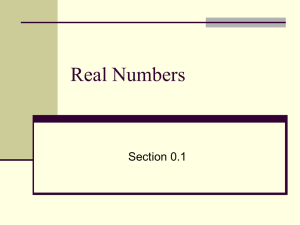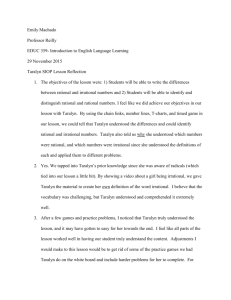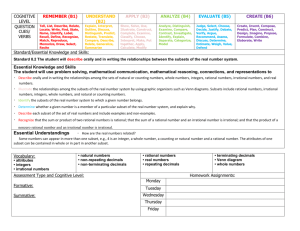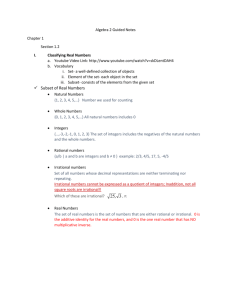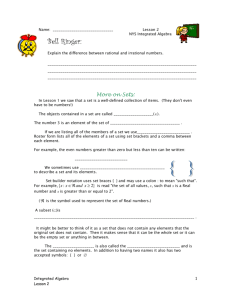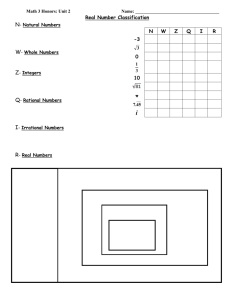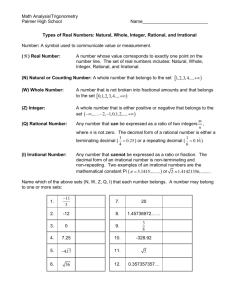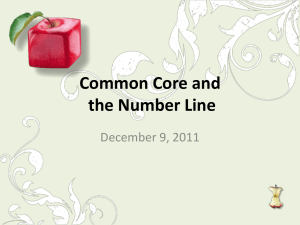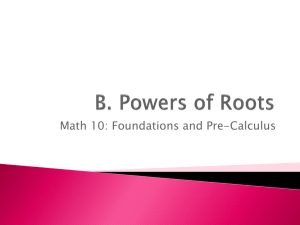Integrated Algebra B
advertisement
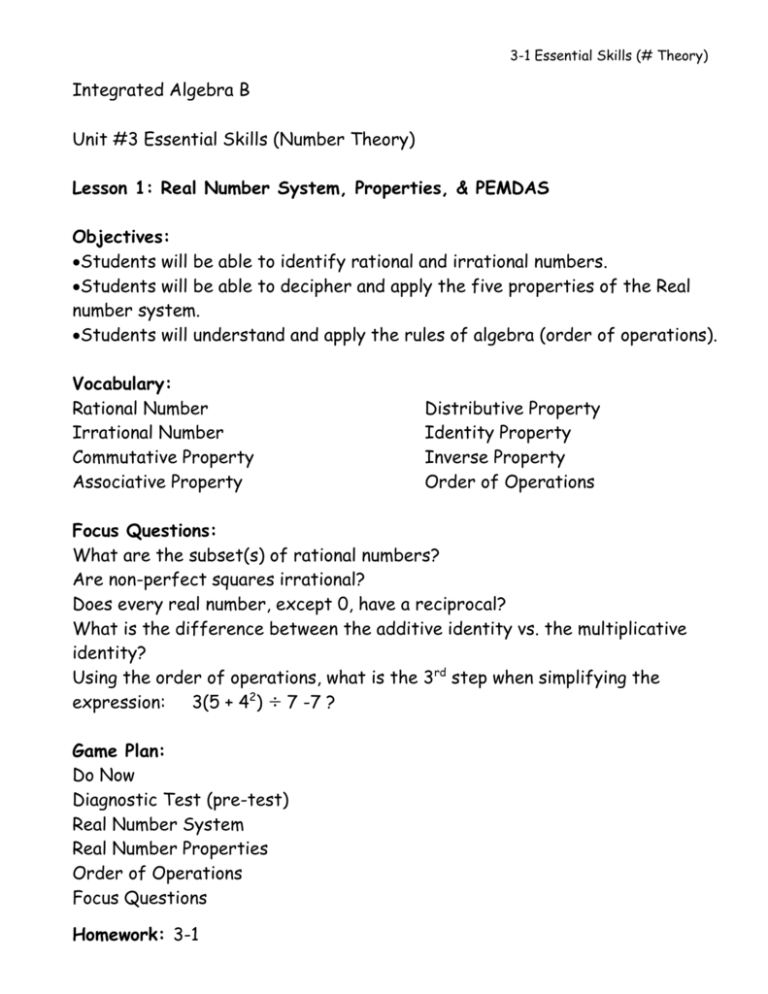
3-1 Essential Skills (# Theory) Integrated Algebra B Unit #3 Essential Skills (Number Theory) Lesson 1: Real Number System, Properties, & PEMDAS Objectives: Students will be able to identify rational and irrational numbers. Students will be able to decipher and apply the five properties of the Real number system. Students will understand and apply the rules of algebra (order of operations). Vocabulary: Rational Number Irrational Number Commutative Property Associative Property Distributive Property Identity Property Inverse Property Order of Operations Focus Questions: What are the subset(s) of rational numbers? Are non-perfect squares irrational? Does every real number, except 0, have a reciprocal? What is the difference between the additive identity vs. the multiplicative identity? Using the order of operations, what is the 3rd step when simplifying the expression: 3(5 + 42) 7 -7 ? Game Plan: Do Now Diagnostic Test (pre-test) Real Number System Real Number Properties Order of Operations Focus Questions Homework: 3-1 3-1 Essential Skills (# Theory) The Real Number System Rational vs. Irrational Any non-perfect square is irrational. ( 5, 7, 11, 33 ) 3-1 Essential Skills (# Theory) Practice: True or False -3 is a whole number. _______ 9 is an irrational number. _______ 0 is a natural number (counting). _______ 1 is a rational number. _______ 3 All real numbers are either rational or irrational numbers. _____ Every whole number is a rational number. _______ All natural numbers are integers. _______ Sum it All Up: For each item, choose the letter that defines the item. A. B. C. D. E. can be written in the form a/b where a and b are integers and b 0 non-repeating and non-terminating decimals has an integer as its square root the set of counting numbers plus 0 consists of the rational and irrational numbers ______irrational numbers ______whole numbers ______rational numbers ______real numbers ______perfect square numbers 3-1 Essential Skills (# Theory) Properties of Real Numbers Property Addition Multiplication Commutative “community” a+b= b+a (a)(b)= (b)(a) Associative “regroup” (a+b) +c= a + (b + c) (ab) c= a (bc) Identity “Back to itself” a + 0= a a(1)= a Inverse “Undo” a + (-a) = 0 1 a ( )= 1 a Distributive “mail man” a (b+c) = ab + ac a (b -c) = ab – ac Examples: 3-1 Essential Skills (# Theory) Name the property illustrated for each example below: a] 3 • 1 = 3 ______________ b] 2 + 3 = 3 + 2 ______________ c] 2 + ( 3 + 4 ) = ( 2 + 3 ) + 4 ______________ d] 2 • ( 3 + 4 ) = 2 • 3 + 2 • 4 ______________ e] 3 + (-3) = 0 ______________ f] 5 • 1 = 5 ______________ g] 2 • ( 3 ) = 3 • ( 2 ) ______________ 1 h] 17 ( ) = 1 ______________ 17 Order of Operations PEMDAS The order of operations are the rules of algebra. P E M D A S Remember to perform multiplication/division & addition/subtraction from left to right. 3-1 Essential Skills (# Theory) U-Try Practice: 9 – 3 + 6= (7+2)2 14 = 2 2 (5 2) -8 + -3 5! -3! = 50 + -7 = 1.43(2) = - -4= -2(-3)2 + 4(-3) = (-2 + 6)2 + [23 -1] = 215 = 2 106 64 = 2! 4! = 3! 22 31 52 111 = 37 – 4 = 2(2)2 + 4(2) – 8 = - 49 = -4 + 32 4–2= 3-1 Essential Skills (# Theory) Name: _______________ 3-1 Essential Skills Integrated Algebra B Ms. Torok 1). State whether each number below is rational or irrational. 16 -2 -8 3 0 2 2 3 1. 6 4.627803 2 8 - 25 1 2 2). State the property illustrated in each of the following: a) 5 + (-6) = (-6) + 5 _________________ b) (-7· 3)4 = -7(3·4) _________________ c) 8.5 + 0 = 8.5 _________________ d) -11·1 = -11 _________________ 5 2 2 5 e) ( ) ( )= 1 _________________ 3). Does the commutative property hold for subtraction? Explain your answer and give an example to support it. Back 3-1 Essential Skills (# Theory) Evaluate each expression: 4). If r= 2 and s= -7, then find r - s. 5). What is the value of (b – b0) a+1 when a= -4 and b= 3? 6). What is the value of the expression -4x2 + 5x when x = -3? 7). What is the value of the expression 80 1 - a + b2 when a= -2 and b= -3? 8). What is the value of the expression (x 1)! when x = 4. 4

